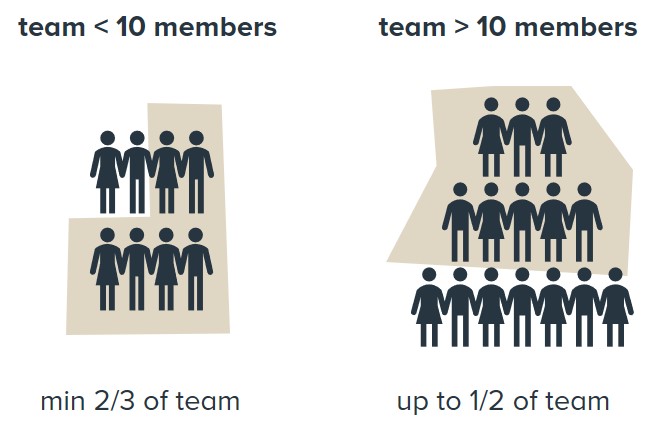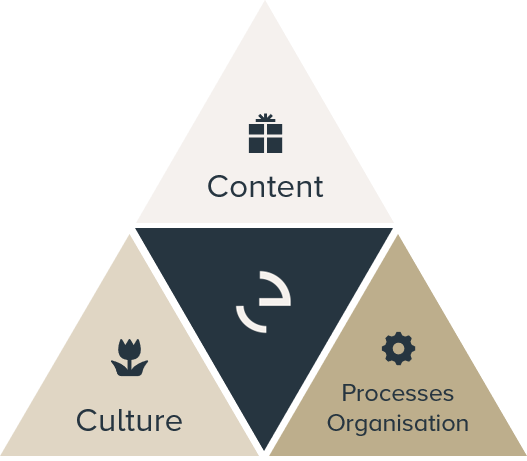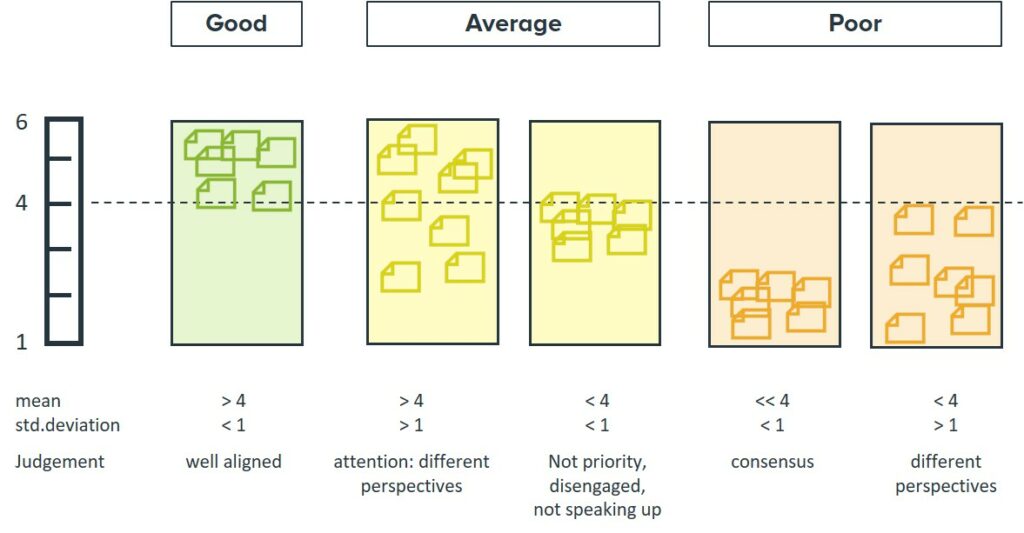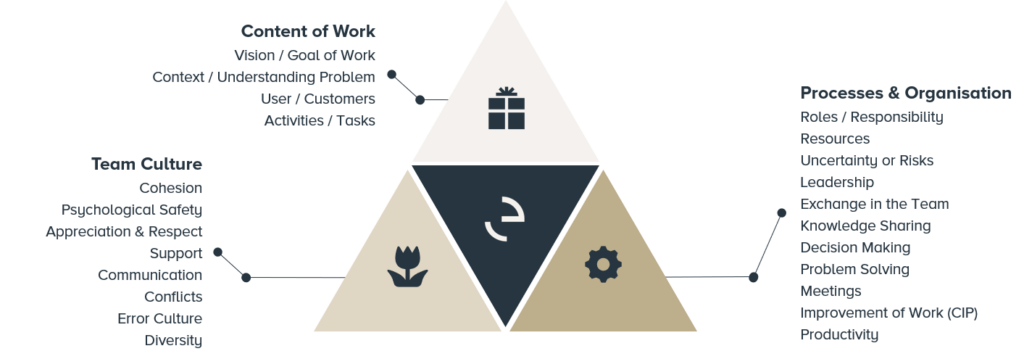Check some details first
Check that the results of your team are displayed (company ID). If the wrong results are displayed, reload the page (F5) or click here.
The following feedback was taken into account:
For meaningful results, you need sufficient feedback from your team. The absolute number depends on the size of the team. The following is a guideline:

- For small teams of less than 10 people, about 2/3 of the team members should complete the compass.
- For larger teams of more than 10 people, up to 50% of the team members can participate.
If you still have too few answers, motivate more people to fill in the evores compass. The analysis at the beginning is very important so that you can work on the right and important points afterwards.
Was it clear to all participants for which team you had to fill in the questionnaire? Practically all persons should tick either 5 or 6 (green). If the assignment was not clear, the results are not meaningful. Depending on the results, either invite more people for the evores compass or start a new survey. When inviting people, clearly communicate which team or project you are doing the survey for.
If you are satisfied with the quality of the data so far, you can look forward to the results!
Summary of the Results
What makes teams successful in the first place?
The literature contains a wide variety of contributions on what makes for successful teams. The evores compass contains many different sources and models (detailed sources). The goal of cooperation in a group is that all team members can make their best contribution in a targeted manner. This means that the team members should be able to contribute their potential to the group and, from the point of view of the company or the project, this effort should be directed towards the common goal. This requires certain prerequisites, which can be grouped as follows (see also figure below).
- The team needs a clear understanding of the problem to be solved and the context (content of work).
- The team needs a supportive team culture.
- The team needs minimal processes and organisation for collaboration.
The areas are split and described in more detail below. The results are ordered according to these areas.

The following figure shows at a glance how well the team members assess the current situation in these three areas.
How does a good assessment emerges?
Different team members Your team works well where all team members agree that it works well. Each question was answered on a scale from 1 (not at all true) to 6 (completely true). The average of all participants’ answers should be above 4.0-4.5, i.e. in the top third of possible answers.

Furthermore, it is important that all team members assess a question similarly, i.e. distribute similar marks. For this reason, the standard deviation (i.e. the spread) of the answers to an area or a question should not be greater than 1.
At the end, an algorithm calculates a single corrected value from the mean and standard deviation, which is shown above. This means that the higher the standard deviation, the further the mean is corrected downwards. A mean grade 4 with a large standard deviation is thus assessed worse than a grade 4 with a small standard deviation, because some people have given a significantly lower grade. If the speedometer is in the green zone, then this is judged as good by the participants and does not necessarily require your attention.
When is your attention required?
Your attention is required when everyone agrees that things are not going well. This is the case with a medium to low average of responses below 4.0. You can look more closely for the causes in the more detailed results below.
You should also look more closely if the spread of answers is large, i.e. the standard deviation is over 1. This is because very good and very bad marks were distributed in a certain question and the team members experience the situation differently. It may be that not all team members have a sufficient overview of the work or that for certain people the team culture or the organisation is not supportive. And in a team it is important to have all people on board, otherwise this can lead to inefficient working with misunderstandings or even to the failure of the project. Depending on how low the corrected value is, the category is shown as light green or orange. These categories require your attention.
Detailed Results by Category
The three large areas are divided into 23 finer categories according to the figure below. This allows you to understand the above assessment in more detail. The evores compass consists of around 75 questions, which were answered anonymously and independently by selected team members. Each question is assigned to one or more categories. For the evaluations, the average of all answers per category and the dispersion of all answers are calculated.

A) Clear content of work
All team members need a clear common understanding of the task they are to fulfil and the context of their challenge. With this understanding, the contributions of the individual team members can flow together efficiently and purposefully into a common result. It does not matter how this coordination takes place among the team members. What is important is the common understanding of the challenge and the mutual contributions. In the following chart, the mean and standard deviation of all answers are given for the different categories. Look out for categories where the mean (light brown) is below 4.0 OR the standard deviation (black) is above 1.0.
The different categories of the content of work are described in more detail in Table 1.
| Category | Description |
|---|---|
| Vision / Goal of the Work | Team members need to know exactly what the challenge is and by when the goal is to be achieved. If the vision or the goal is not clear, it will be interpreted differently by the individual persons. People thus work in different directions and their efforts completely offset each other in the worst case, similar to rope pulling. A bonus for cooperation is when members can be personally motivated by a particularly inspiring, worthwhile goal. |
| Context / Understanding of the problem | In diverse teams with different backgrounds, it is especially important that all members develop a common understanding of the problem and the context of their work. Through their experience, people have different perspectives, knowledge and assumptions that need to be discussed together. With this shared knowledge, the coordination of the collaboration and the individual contributions becomes much easier. |
| User / Customers | Who uses the results of the joint work? Every piece of work has a client or a user, this can also be within your own organisation. It is important that everyone agrees who their clients are and what their needs are. This way you can incorporate these needs into their work or even cooperate with the clients on a regular basis during the work. |
| Activities / Tasks | What steps or tasks are required to achieve the common goal? Here, a common understanding is particularly important for efficient work. The activities or intermediate results should fit together like a jigsaw puzzle. The activities must be clear, realistic and linked to a clear responsibility for all team members. This overview is also motivating, as the people clearly see their contribution to the overall project. |
B) Supportive Team Culture
Teams need a supportive and secure corporate culture as a basis. This is not directly visible, but can be observed in all areas of cooperation: How do people treat each other in the team? It is important that all members experience your team culture as supportive. In the following chart, the mean and standard deviation of all answers are given for each of the different categories. Pay attention to categories where the mean (light brown) is below 4.0 OR the standard deviation (black) is above 1.0.
The different categories of team culture are described in more detail in Table 2.
| Category | Description |
|---|---|
| Cohesion | The cohesion of the group is an important basis for a trusting and supportive cooperation. Do the members work together as a team to achieve a common goal or is it more of a competition or fight against each other? |
| Psychological Safety | Psychological safety is absolutely central to the team’s progress and the quality of the solution. It means that team members are not punished in any way if they make mistakes, disagree or bring questions and new ideas. |
| Appreciation & Respect | Appreciation of one’s own work is the basis of all motivation and belonging to the team. This also applies to the work of the whole team in the rest of the company. Respect means that all persons are treated decently and have a voice that is heard. |
| Support | How well do team members support each other and how easy is it to get support from others? |
| Communication | Communication is a very comprehensive, subjective and important topic. Regardless of the type of communication, its purpose must be fulfilled. If important information is exchanged in a timely manner, communication is factual, clear and constructive, etc., it is important that the communication is effective. |
| Conflicts | Conflicts between team members are essential for the functioning and progress of a team. Accordingly, they should be seen as an opportunity and used constructively. |
| Error Culture | Errors are important for development. What is the attitude in the team towards mistakes, how do you communicate and learn from mistakes? |
| Diversity | Diversity of people, backgrounds, origins etc. is a fact of life in many teams and also desirable for many activities. What is important, however, is the attitude of the members towards diversity and how it is used. |
C) Supportive Processes and Organisation
The team needs minimal processes and organisation for collaboration. These are the visible structures of collaboration. Often they are written down in some way, but not necessarily. It is important that they are clear to all team members and are seen as supportive. The following chart shows the mean and standard deviation of all answers for the different categories. Look for categories where the mean (light brown) is below 4.0 OR the standard deviation (black) is above 1.0.
The different categories of the Processes and Organisation area are described in more detail in Table 3.
| Category | Description |
|---|---|
| Roles / Responsibility | In a team, there should be clarity about who is working, who has what responsibility and how all members contribute to the common goal. With participation, the commitment and dedication of the people grows. And a team emerges from the individuals. |
| Resources | Teams need the necessary resources and the right team composition to successfully complete their task. Are the resources allocated or is it clear who will take care of missing resources? |
| Uncertainty or Risks | Every project has uncertainties or, colloquially, risks that need to be monitored and addressed if necessary. Have the reasons why the team might not achieve their goal been discussed and is this assessment regularly reviewed? |
| Leadership | Teams do not necessarily need leadership, but they do need guidance and support. Certain processes need moderation and decision-making. Are they there? Do the members feel accompanied and supported to the right extent or are they rather left alone or even restricted by micro-management? |
| Exchange in the Team | Exchange about the current status of the work is important so that the individual contributions can be well coordinated. In addition, this exchange is important in order to delegate (partial) work to other team members or to receive tips for one’s own work. |
| Knowledge Sharing | Is knowledge, information and experience documented and shared by team members? |
| Decision Making | Decisions have to be made continuously during the work. Accordingly, it is important to do this efficiently and within the right framework. Can people also make decisions themselves and how are they involved? In many areas it is important that people are involved before decisions are made and that they are informed afterwards. |
| Problem Solving | Problems also arise constantly during cooperation. Has it been defined how to deal with a new problem and is the resolution of problems efficient? |
| Meetings | Meetings are the most efficient form of exchange but also a frequent cause of inefficiency and frustration among team members. The reason is that they are often poorly managed and left to run aimlessly or misused as a stage. So are the most important basics for efficient meetings met? |
| Improvement of Work (CIP) | The continuous improvement of one’s own work is the quintessence of many other factors. Does the team as a whole have the feeling that it is moving forward together, or are certain conditions for this not met and the same building sites are encountered again and again? |
| Productivity | Productivity is the result that is achieved with a certain amount of work. It is important for the company, but also for the satisfaction of the employees. How are the different factors subjectively assessed by the team members? |
Next Steps
From the results above, you can deduce in which areas of cooperation the team members give good marks and where there is potential for improvement, if any. Of course, not every category is equally important for your team, your industry and the type of work you do. Take this into account in the further procedure, which could look as follows:
- Interpret the results. What is surprising? Which categories would you like to improve? Focus on categories that are important for your work and at the same time rated low and don’t take on too much at once! For example, choose the 5 most important categories, make a ranking list and cross out the last 2 or 3.
- Analyse the chosen category in more detail with your team. What are the problems? What would have to be different for the category to be rated green? What is needed for team members to contribute successfully? If you want to shorten this analysis, order the detailed evaluation of the results for your team from evores. This gives you even more insights without additional input from your team.
- Work on the causes. Improve collaboration.
- Check the progress at regular intervals, for example with the evores compass. If you are satisfied with the result, you can move on to the next category.
Additional Services
evores supports you throughout the entire process, if you wish. This starts with the interpretation of the results and goes on to more detailed analyses with the team to the accompaniment of improvement projects and the monitoring of success.
Much more information can be gleaned from the evores compass data. For example, there are further interesting evaluations and in particular the answers to the individual questions provide very precise information about the areas in which cooperation can be improved. Order the reportor a presentation and interpretation of the results (link to the shop in the banner below).
Sometimes further on-site team analysis is needed or you want support in planning and implementing the improvement? The evores backpack is full of tools to structure the content of the work more clearly, to improve the team culture or to define better processes. Together we create long-term success because your behaviour and processes automatically change with the new tools.
evores compass
additional services around evores compass
Feedback evores compass
We welcome every evaluation and feedback on the evores compass! So that the tool becomes even better and more teams can benefit from it.